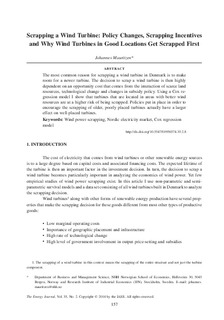| dc.contributor.author | Mauritzen, Johannes | |
| dc.date.accessioned | 2017-09-01T06:47:57Z | |
| dc.date.available | 2017-09-01T06:47:57Z | |
| dc.date.created | 2014-08-27T14:24:24Z | |
| dc.date.issued | 2014 | |
| dc.identifier.citation | Energy Journal. 2014, 35 (2), 157-181. | nb_NO |
| dc.identifier.issn | 0195-6574 | |
| dc.identifier.uri | http://hdl.handle.net/11250/2452635 | |
| dc.description.abstract | The most common reason for scrapping a wind turbine in Denmark is to make
room for a newer turbine. The decision to scrap a wind turbine is then highly
dependent on an opportunity cost that comes from the interaction of scarce land
resources, technological change and changes in subsidy policy. Using a Cox regression
model I show that turbines that are located in areas with better wind
resources are at a higher risk of being scrapped. Policies put in place in order to
encourage the scrapping of older, poorly placed turbines actually have a larger
effect on well-placed turbines | nb_NO |
| dc.language.iso | eng | nb_NO |
| dc.subject | Wind Power Scrapping | nb_NO |
| dc.subject | Nordic Electricity Market | nb_NO |
| dc.subject | Cox regression model | nb_NO |
| dc.title | Scrapping a wind turbine: Policy changes, scrapping incentives and why wind turbines in good locations get scrapped first | nb_NO |
| dc.type | Journal article | nb_NO |
| dc.type | Peer reviewed | nb_NO |
| dc.description.version | publishedVersion | nb_NO |
| dc.rights.holder | Energy Journal, 2014 | nb_NO |
| dc.subject.nsi | VDP::Social science: 200::Economics: 210::Business: 213 | nb_NO |
| dc.subject.nsi | VDP::Social science: 200::Economics: 210::Economics: 212 | nb_NO |
| dc.source.pagenumber | 157-181 | nb_NO |
| dc.source.volume | 35 | nb_NO |
| dc.source.journal | Energy Journal | nb_NO |
| dc.source.issue | 2 | nb_NO |
| dc.identifier.doi | 10.5547/01956574.35.2.8 | |
| dc.identifier.cristin | 1149821 | |
| dc.relation.project | Norges forskningsråd: 209697 | nb_NO |
| cristin.unitcode | 191,10,0,0 | |
| cristin.unitname | Institutt for foretaksøkonomi | |
| cristin.ispublished | true | |
| cristin.fulltext | original | |
| cristin.qualitycode | 2 | |
